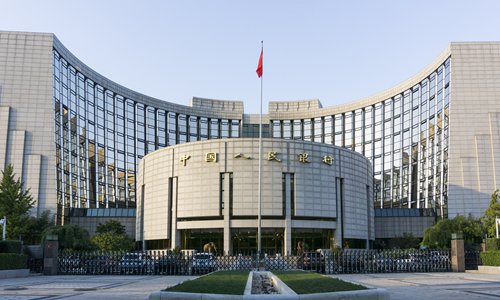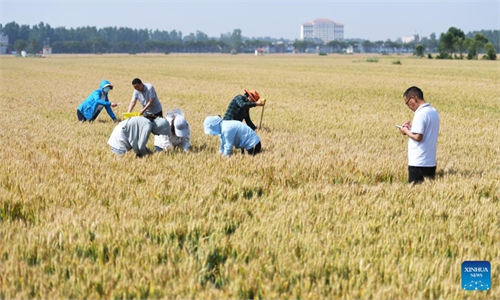
The headquarters of the People's Bank of China in Beijing Photo: IC
The vast majority of small and medium-sized banks in China remain within safe limits in terms of central bank ratings, an official of the People's Bank of China (PBC), the country's central bank, said on Wednesday, assuring the markets of overall financial robustness in the wake of recent Western media hype over problems at four rural banks in Central China's Henan Province.
In pointed remarks, the PBC official also urged unbiased reporting of the financial landscape, while injecting optimism over a continued recovery in the economy and vowing ramped-up implementation of a prudent monetary policy as part of efforts to keep the economic operation within a reasonable range.
Since the village bank incidents occurred in Henan, the central bank has actively cooperated with local governments and regulatory authorities to prudently handle the incidents, guide the PBC branches to play their part in safeguarding regional financial stability and offer liquidity risk monitoring and emergency support, Sun Tianqi, chief of the PBC's financial stability bureau, told a press conference in Beijing.
The country's financial risks are overall controllable, with 99 percent of its banking sector assets within safe limits, Sun said.
As of the end of 2021, banks boasted assets of 345 trillion yuan ($51.26 trillion), accounting for 90 percent of the total financial assets, he disclosed, speaking of a steady banking sector making the case for financial stabilization.
The PBC official also noted results of central bank ratings of 4,398 banking institutions for the fourth quarter of last year, which showed 4,082 institutions, 93 percent of the total in number terms or 99 percent of the total as measured by assets, landed a 1-7 rating range, suggesting financial security.
Notably, 24 large banks got a premium rating of 1-5, with their assets making up 70 percent of the banking institutions taking part in the ratings, according to Sun, describing them as the ballast of the financial sector.
Institutions rated as 8 or beyond are categorized as high-risk ones, with 316 such institutions representing merely 7 percent of the total in number terms, or just 1 percent in asset terms, according to the central bank official.
The numbers offer a glimpse into the banking sector at large, which remains well-grounded despite some isolated trouble at a handful of village banks in Henan and East China's Anhui Province.
In an effort to address concerns among certain depositors who have reported difficulty in withdrawing money from the affected village banks, local banking and insurance regulatory authorities in the two provinces have responded with plans to advance deposits for people initially with combined assets of no more than 50,000 yuan apiece, media reports said.
However, despite the swift actions to address the cases, many foreign media outlets have been hyping the issue and suggesting systemic risks at China's small banks.
Media coverage of high-risk institutions is supposed to be part of an impartial, comprehensive and precise reporting of the overall financial risk evaluation that involves some 4,000 "good" institutions, Sun remarked.
The country is home to the world's largest banking market, Xiao Yuanqi, deputy head of the China Banking and Insurance Regulatory Commission, disclosed earlier this year.
There are nearly 4,000 small and medium-sized banks in China, with assets amounting to 92 trillion yuan, or 29 percent of the total, according to Xiao.
Breaking down the numbers, there are 147 city commercial banks, 2,196 rural credit cooperatives, and 1,651 village banks.
The troubles at some village banks ought to be a wake-up call for more effective regulatory oversight of these banks, which tend to compete for deposits with higher-than-average returns; however, they might fail to repay deposits amid economic headwinds, Yi Xianrong, a professor of economics at Qingdao University, told the Global Times on Wednesday.
Yi urged a regulatory toughening of notably local government financing vehicle-backed village banks, as such banks could be opaquely structured and potentially dent depositors' confidence.
Still, according to a recent article run by International Finance News, most village banks are known for relatively stable operations, although village bank earnings at large have taken a hit from the virus fallout since 2020.
Also at Wednesday's press conference, Ruan Jianhong, PBC spokesperson and head of the central bank's statistics and analysis department, said that the country's macro leverage ratio has stayed conspicuously lower than other major economies, succeeding in supporting a swift economic recovery with comparatively less new debt since the pandemic.
The country's macro leverage ratio recorded a net decline for five consecutive quarters starting in the fourth quarter of 2020, providing precious policy leeway for the country, according to Ruan.
As of the end of 2021, the US saw its leverage ratio jump 25.7 percentage points from its end-2019 level. The upsurge in Japan's case was 39.5 percentage points and the eurozone recorded an increase of 21.4 percentage points.
By comparison, China posted a macro leverage ratio increase of 16.5 percentage points during the period, Ruan revealed, noting that the country banked on a mild growth in its macro leverage ratio to underpin relatively high economic growth and low inflation.
Reiterating that the fundamentals of the Chinese economy remain on track to turn for the better, the PBC said that the economy has seen a marked rebound in the wake of the accelerated implementation of pro-growth measures.
The central bank pledged to step up implementation of a prudent monetary policy among other efforts to keep the economic operation within a reasonable range.



